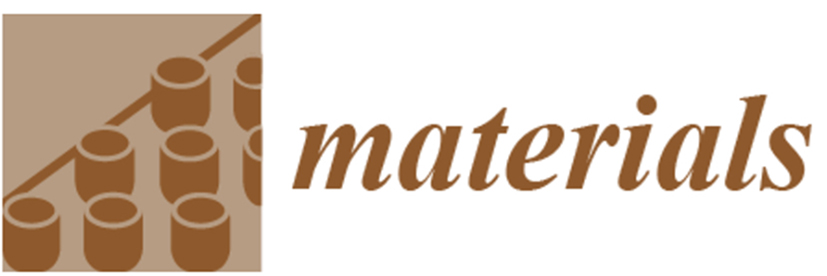ISSN (online): 1996-1944
Call of the Journal:
- Advanced Carbon Materials in Water Treatment or Separations Technology
- Advanced Functional Hybrid Materials for Novel Biomolecular Electronics
- Advances in Biomaterials | Design, Synthesis, Characterisation and Biomedical Application
- Advances in Construction and Building Materials
- Advances in Green Construction Materials
- Assessment of Metallurgical and Mechanical Properties of Welded Joints via Numerical Simulation and Experiments
- Carbon Compounds-Reinforced Ceramics
- Concrete and Waterproofing Materials | Development of Waterproofing Technology for Buildings and Civil Concrete Structures
- Corrosion Inhibitors for Steel | Experimental and Theoretical Studies
- Damage and Failure of Polymers, Polymer-Like Materials, Adhesives and Polymer Nanocomposites
- Development of Energy Storage or Conversion Element Based on Various Nano Materials
- Dyes | Synthesis, Properties, and Applications
- Dynamic Behavior of Ceramic Composites
- Flexible Sensors and Actuators for Novel Wearable Solutions
- Fundamentals and Applications of Bionano Sensor Techniques
- Graphene Foam Based Composites
- Growth and Application of Foam-Based Materials
- High Performance Concrete
- Hybrid Noble Metal/Graphene Aerogels | Synthesis, Characterization and Applications for Chemical Sensing and Biosensing
- Hydrogen Storage and Fuel Cells | Materials, Characterization and Applications
- Load Test and Numerical Analysis on Construction Materials
- Machining and Surface Properties of Steel Parts
- Materials under Extreme Conditions | Technologies for CRMs Reduction, Substitution and Recovery
- Microplastics and Nanoplastics | From Resource to Pollution
- Mineral-Bonded Composites for Enhanced Structural Impact Safety
- Modification and Processing of Biodegradable Polymers
- Nanostructured Semiconductors for Photoinduced Applications
- Novel Inorganic Adsorbents for Environmental Purification
- Numerical Simulation and Experimental Studies of Wave Phenomena in Composite Materials
- Performance Research of Polyurethane Foams and Composites
- Physics, Electrical and Structural Properties of Dielectric Layers
- Precision and Ultra-Precision Subtractive and Additive Manufacturing Processes of Alloys and Steels
- Processing and Thermal Properties of Hybrid Composites
- Recent Advances in 3D Printing for Biomaterials
- Recent Progress in the Development, Material Properties, and Post-Processing of Additively Manufactured Components
- Silica and Silica-based Materials for Biotechnology, Polymer Composites and Environmental Protection
- Study on the Modification and Compressive Properties of Concrete Buildings Materials
- Superconductors for Opto-Nano and Micro-Electro-Mechanical Systems (O-N/MEMS)
- Synthesis and Characterization of Hybrid Nanomaterials and Nanocomposites
- Synthesis, Properties and Applications of Polymer Blends
- Testing of Materials and Elements in Civil Engineering
- The Science and Technology of 3D Printing
Jan
2021
Dec
2021
Interest in colored substances has changed radically over time. While until the middle of the last century, the main goals of research were potential applications in the textile and photonic industries, nowadays due to their unique photophysical and photochemical properties, dyes have grown in particular relevance to several fields of science: technology engineering, pharmacology, medicine, and the environment for its application in new forms of renewable energy. The expansion and unlimited variation that can be made in the base molecular structures of the most diverse classes of dyes in an attempt to enhance and improve their applicability in a given scientific field and/or application has been widely reported in recent studies that demonstrate their broad spectrum of potential uses and their high promise. Thus, this Special Issue has as its primary challenge the dissemination of information regarding the design and synthesis of new dyes which, regardless of their structure type, should be studied in relation to their photophysical, photochemical, and, when appropriate, photobiological properties in order to prove their relevance in some applications, such as solar organic cell sensitizers, photochromic materials, liquid crystal displays, organic light-emitting devices, organic semiconductors, dye-affinity chromatography for the proteins and enzymes purification, fluorescent sensors and photodynamic therapy photosensitizers. Review articles and communications addressing these topics are also welcome.
Keywords: Synthesis of new dyes; Physical and chemical properties; Photochemical, ecological, or biological studies; Structure-activity relationships.
Dyes | Synthesis, Properties, and Applications
Interest in colored substances has changed radically over time. While until the middle of the last century, the main goals of research were potential applications in the textile and photonic industries, nowadays due to their unique photophysical and photochemical properties, dyes have grown in particular relevance to several fields of science: technology engineering, pharmacology, medicine, and the environment for its application in new forms of renewable energy. The expansion and unlimited variation that can be made in the base molecular structures of the most diverse classes of dyes in an attempt to enhance and improve their applicability in a given scientific field and/or application has been widely reported in recent studies that demonstrate their broad spectrum of potential uses and their high promise. Thus, this Special Issue has as its primary challenge the dissemination of information regarding the design and synthesis of new dyes which, regardless of their structure type, should be studied in relation to their photophysical, photochemical, and, when appropriate, photobiological properties in order to prove their relevance in some applications, such as solar organic cell sensitizers, photochromic materials, liquid crystal displays, organic light-emitting devices, organic semiconductors, dye-affinity chromatography for the proteins and enzymes purification, fluorescent sensors and photodynamic therapy photosensitizers. Review articles and communications addressing these topics are also welcome.
Keywords: Synthesis of new dyes; Physical and chemical properties; Photochemical, ecological, or biological studies; Structure-activity relationships.
ADS-Astrophysics Data System, AGORA(FAO), CAB Abstracts(CABI), Chemical Abstracts (ACS), Current Contents-Engineering, Computing & Technology (Clarivate Analytics), DOAJ, Ei Compendex/Engineering Village (Elsevier), Genamics JournalSeek, Global Health (CABI), HINARI (WHO), Inspec (IET), Journal Citation Reports/Science Edition (Clarivate Analytics), Julkaisufoorumi Publication Forum (Federation of Finnish Learned Societies), Norwegian Register for Scientific Journals, Series and Publishers (NSD), Polymer Library (Smithers Rapra), PubMed (NLM), Science Citation Index Expanded – Web of Science (Clarivate Analytics), Scopus (Elsevier), Web of Science (Clarivate Analytics), Zetoc (British Library), CLOCKSS (Digital Archive), e-Helvetica (Swiss National Library Digital Archive), PubMed Central (NLM), Academic OneFile (Gale/Cengage Learning), EBSCOhost (EBSCO Publishing), Energy & Power Source (EBSCO), Engineering Source (EBSCO), Google Scholar, J-Gate (Informatics India), Materials Science & Engineering (ProQuest).
Info at: www.mdpi.com/journal/materials/apc
Guest Editor
Prof. Lucinda V. Reis









